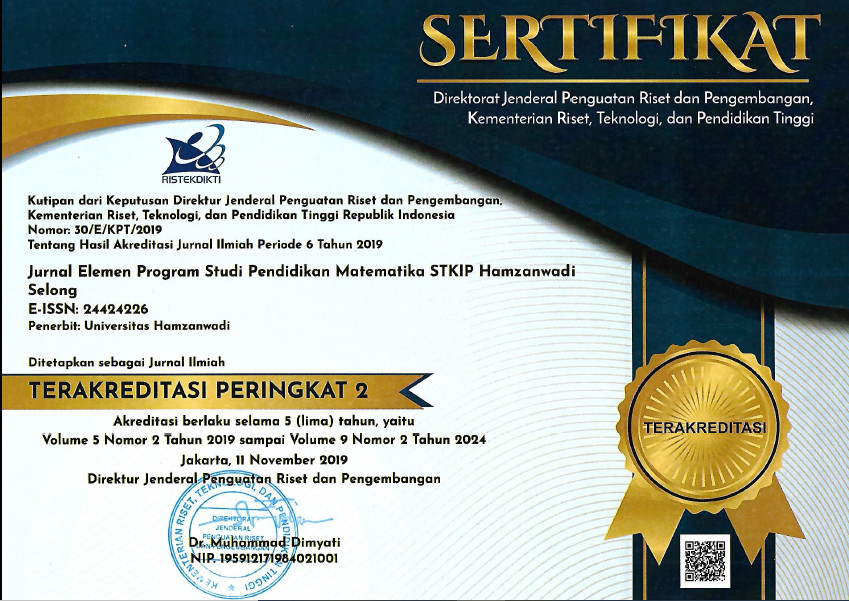Pengembangan Buku Siswa Materi Jarak pada Ruang Dimensi Tiga Berbasis Science, Technology, Engineering, and Mathematics (STEM) Problem-Based Learning di Kelas X
DOI:
https://doi.org/10.29408/jel.v3i1.273Keywords:
Distance, 3-dimentional-space, development teaching material, Science, Technology, Engineering, and Mathematics (STEM) Problem-Based LearningAbstract
This aim of this research is to produce a valid and practical teaching material on the matter 3-dimensional-space based Science, Technology, Engineering, and Mathematics (STEM) Problem-Based Learning and to know the potential effect from it. This research is qualitative with Design Research method. The subject in this research is 44 students form X MIA 4 SMA Negeri 19 Palembang. The stage of this research is preparation, formative evaluation consist of self evaluation, development, and field test. The data collection techniques are walktrough, documen, observation, and test. Based on this result, it has gained a valid teaching material on the matter 3-dimensional-space based Science, Technology, Engineering, and Mathematics (STEM) Problem-Based Learning in its content, construct, and language after passing the expert review and one-to-one stage. The practicabillity of this teaching material is looked from small group development stage. The potential effect from this teaching material is looked from the test result after learning process. The result of the test percentage is at 54% have reached the Minimal Complete Criteria. It shows that students’s book based STEM Problem-based Learning can be used in learning of distance in 3-Dimensional-Space lesson.References
Akker, J. V., Bannan, B., E.Kelly, A., Nieveen, N., & Plomp, T. (2013). Educational Design Research. Netherlands: SLO.
Ahmadi, I. K., & Amri, S. (2014). Pengembangan dan model pembelajaran tematik integratif. Jakarta: Prestasi Pustakaraya.
Aisyah, N. (2009). Diktat Geometri. Program Studi Pendidikan Matematika FKIP Universitas Sriwijaya
BSNP. (2006). Standar Isi Untuk Pendidikan Dasar dan Menengah. Jakarta: Kementerian Pendidikan Nasional.
Depdiknas. (2008). Panduan Pengembangan Bahan Ajar. Jakarta: Depdiknas.
Handayani, F. (2014). Pengembangan Lembar Kerja Siswa (LKS) Berbasis Science , Technology, Engineering, and Mathematics (STEM) pada Materi Hidrolisis Garam. Univeristas Syiah Kuala, 24.
Hapiziah, Suri. (2015). Pengembangan bahan ajar kimia materi laju reaksi berbasis STEM Problem-Based Learning kelas XI SMA N 1 Indralaya Utara. Skripsi. Indralaya: FKIP Unsri.
Honey, M., Pearson, G., & Schweingrube, H. (2014). STEM Integration in K-12 Education: Status, Prospects, and an. Washington DC: National Academy of Sciences.
Kemdikbud. (2013). Kompetensi Inti dan Kompetensi Dasar Sekolah Menengah Pertama (SMP)/Madrasah Tsanawiyah (MTs). Jakarta: Kemdikbud RI.
Poerwati, L.E dan Sofan Amir. (2013). Panduan Memahami Kurikulum 2013. Jakarta: Prestasi Pustakaraya.
Prastowo, A. (2012). Panduan Kreatif Membuat Bahan Ajar Inovatif. Yogyakarta: DIVA Press.
Rizki, Muhammad. (2013). Kesulitan Siswa dalam Menyelesaikan Soal-soal Pemecahan Masalah Matematika Materi Geometri di Kelas IX SMP Patra Mandiri 2 Sungai Gerong. Skripsi. Indralaya: FKIP Unsri.
Sanders, Mark. (2009). STEM, STEM Education, STEMmania. The Technology Teacher. (2009), 20-26
Septiana, Rosmalia. (2011). Pengembangan Bahan Ajar Pendidikan Matematika Realistik Indonesia (PMRI) pada Pokok Bahasan Garis dan Sudut di SMP RSBI. Skripsi. Indralaya: FKIP Unsri.
Susanto, A. (2013). Teori Belajar dan Pembelajaran si Sekolah Dasar. Jakarta: Prenada Media.
Tripathi, P. N. (n.d.). Problem Solving In Mathematics: A Tool for Cognitive. State University of New York, Oswego, USA, 1. http://cvs.gnowledge.org/episteme3/pro_pdfs/27-tripathi.pdf. Diakses pada 25 Desember 2015
Verma, A. K., Dickerson, D., & McKinney, S. (2011). Engaging Students in STEM Careers with Project-Based Learning—MarineTech Project. Technology and enginerring teacher, 30.
Wirawan. (2011). Evaluasi Teori, Model, Standar, Aplikasi, dan Profesi. Depok: Rajagrafindo Persada.
Zulkardi. (2002). Developing A Learning Environment On Realistic Mathematics Education For Indonesian Student Teacher. Disertasi. ISBN. University of Twente, Enshede. The Nederlands.
Downloads
Published
How to Cite
Issue
Section
License
Authors who publish with the Jurnal Elemen agree to the following terms:
- Authors retain copyright and grant the journal right of first publication with the work simultaneously licensed under Creative Commons Attribution-ShareAlike 4.0 International License (CC BY-SA 4.0).
- Authors are able to enter into separate, additional contractual arrangements for the distribution of the journal's published version of the work (e.g., post it to an institutional repository or publish it in a book), with an acknowledgment of its initial publication in this journal.
- Authors are permitted and encouraged to post their work online (e.g., in institutional repositories or on their website) prior to and during the submission process, as it can lead to productive exchanges, as well as earlier and greater citation of published work.
Jurnal Elemen is licensed under a Creative Commons Attribution-ShareAlike 4.0 International License






